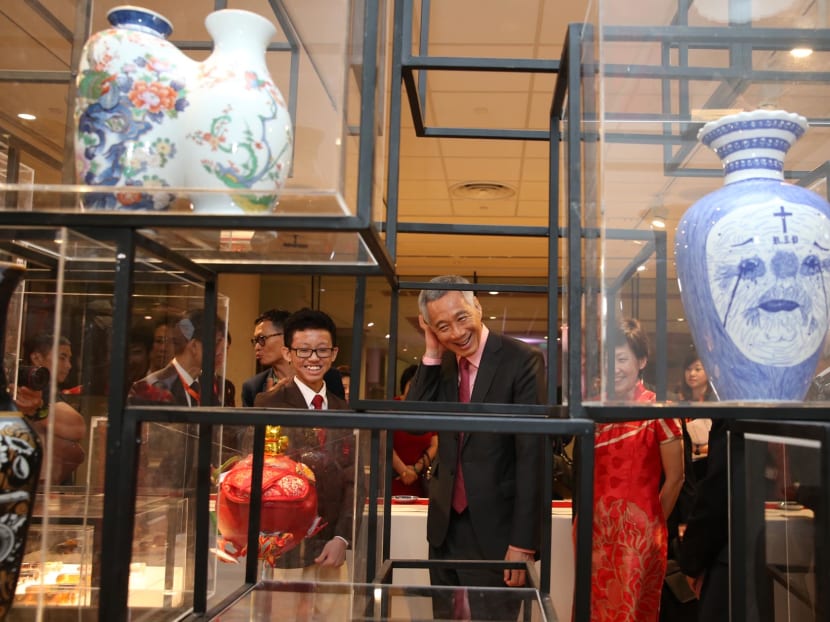Nation’s past, multiracial make-up gave S’porean Chinese ‘distinct cultural identity’: PM
SINGAPORE — Singaporean Chinese have a distinct cultural identity, Prime Minister Lee Hsien Loong said, due to generations of the community having forged their livelihoods here, embracing multiculturalism, and being part of the country’s globalised economy and bilingual education system.

Hwa Chong Institution student Woi Youyang, 15, shows his artwork to Prime Minister Lee Hsien Loong at the Singapore Chinese Cultural Centre on May 19, 2017. PHOTO: Wee Teck Hian
SINGAPORE — Singaporean Chinese have a distinct cultural identity, Prime Minister Lee Hsien Loong said, due to generations of the community having forged their livelihoods here, embracing multiculturalism, and being part of the country’s globalised economy and bilingual education system.
In his Mandarin speech on Friday (May 19) night, at the official opening of the Singapore Chinese Cultural Centre next to the Singapore Conference Hall, Mr Lee also highlighted that “the Singapore Chinese culture” is tied to the Singapore identity.
“When defining the Singapore Chinese culture, it is important to note that our collective experiences and memories over the last 50 years of nation-building have strengthened the Singapore identity. We would therefore call ourselves Singaporean first, before identifying ourselves by our race,” he said.
“So we are Singaporean Chinese. This is also how we identify ourselves internationally.”
The establishment of the cultural centre is a new milestone for Singapore Chinese culture, he said, and the Government strongly supported the project. Those involved in setting it up, which took five years, had to think about how to develop this culture.
“Each country would develop its unique culture based on its environment and history. It is the same for Singapore. Generations have passed and Singaporean Chinese have developed a distinct cultural identity,” Mr Lee said, adding that three key factors contributed to this identity.
“First, our Chinese forefathers, through their way of life, have inculcated in us many positive traditional values,” he said, pointing to the hard work and perseverance of the pioneer generation to build a better future for the next generation “through very challenging times”, and how they believed that their labour had its rewards.
The Chinese community also cared a lot about education and charity, and would contribute what they could to support these causes; they also respected the elders and looked after the young and weak, he said of the other values they held.
Then, Singapore’s globalised economy and the country’s bilingual education policy opened the gateway for Singaporean Chinese to have contact with “the cultures of the East and West”.
“Because we are bilingual, we can interact with friends from different cultures, and understand their perspectives,” Mr Lee said. “Chinese and non-Chinese Singaporeans are able to deepen their engagement. We can also communicate easily with our neighbours in Asia and South-east Asia.”
The other factor that shaped the Singapore Chinese cultural identity is Singapore’s multi-racial and multi-religious society, Mr Lee said.
From the beginning, although the Chinese were the majority, they did not demand that the minorities adopt the Chinese culture or way of life, or speak Mandarin. Every race kept its own traditions and culture, there are also common spaces for the different races to mingle.
“Over time, the different cultures influenced each other and the Singapore Chinese culture has developed its own unique multicultural traits,” Mr Lee said, adding that examples of these can be seen in music performances or artworks created.
At the new cultural centre’s Creativity in Pulses special exhibition, for example, one of Singapore’s leading sound-media artists, Mr Zulkifle Mahmod, a Malay, has created an installation featuring an audio component that draws reference to popular Chinese tunes.
“The Chinese culture that the Singapore Chinese Cultural Centre promotes will be a Singaporean-centric one,” Mr Lee said.
Among the programme line-up at the centre this month, visitors may catch a Wushu showcase with a special appearance by South-east Asian Games gold medallist Vincent Ng, a chinese opera appreciation workshop, as well as a Sing. Lang Concert featuring Xinyao artistes. A May 25 screening of an anthology of short films, titled 667, produced by award-winning filmmaker Royston Tan, is already sold out.






